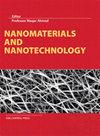各向异性金纳米颗粒在氧化铟锡基底上的形成作为等离子体传感材料
IF 3.3
3区 材料科学
Q2 MATERIALS SCIENCE, MULTIDISCIPLINARY
引用次数: 7
摘要
一种简单的种子介导生长技术已经成功地在固体基质上生长出各向异性的金纳米颗粒。在二元表面活性剂混合物(十六烷基三甲基溴化铵和两种不同分子量的盖层剂,即聚乙烯吡咯烷酮:40000和55000)的存在下,金纳米颗粒的生长进行了。研究了封盖剂的工艺参数、生长时间和分子量对封盖效果的影响。生长时间对纳米颗粒的形状和尺寸有显著影响。较短的生长时间可形成小的球形或方形颗粒,而较长的生长时间可形成较大的颗粒,包括纳米棒、纳米正方形和纳米三角形。采用形状控制剂聚乙烯吡咯烷酮合成了金纳米颗粒。结果表明,以聚乙烯吡咯烷酮40,000为封盖剂,很难获得形状和尺寸均匀的单分散金纳米颗粒。聚乙烯吡咯烷酮55000产生更均匀的形状和大小的金纳米颗粒。因此,这些工艺参数对金纳米颗粒的尺寸、形状、表面密度和均匀性都有影响。该样品被进一步用作检测有毒杀菌剂百菌清的传感材料。传感器系统的灵敏度由在不同介质(空气、去离子水和百菌清溶液)上的横向和纵向表面等离子体共振峰的峰位和强度变化决定。与无金纳米颗粒薄膜的对照实验相比,金纳米颗粒薄膜在30 mM百菌清中的传感器响应出现了两个共振峰。成功地合成了金纳米颗粒薄膜传感器,作为一种具有潜在应用价值的杀真菌剂检测传感材料。本文章由计算机程序翻译,如有差异,请以英文原文为准。
Formation of anisotropic gold nanoparticles on indium tin oxide substrates as a plasmonic sensing material
A simple technique of seed-mediated growth has been successfully performed to grow anisotropy gold nanoparticles on solid substrates. The growth of the gold nanoparticles has been carried out in the presence of a binary surfactant mixture of hexadecyltrimethylammonium bromide with two different molecular weights of a capping agent, namely polyvinylpyrrolidone: 40,000 and 55,000. In this study, the effect of process parameters, growth time and molecular weight of capping agent was investigated. The growth time shows a significant impact on the shape and size of nanoparticles. The shorter growth time produced small spherical to square-like shape particles, whereas bigger particles including nanorods, nanosquares and nanotriangles were formed with longer growth time. The shape controlling agent, polyvinylpyrrolidone, was used to synthesis gold nanoparticles. It was found that monodisperse gold nanoparticles with uniform shape and size are hardly obtained when polyvinylpyrrolidone 40,000 was used as capping agent. Polyvinylpyrrolidone 55,000 produced more uniform shape and size of gold nanoparticles. Thus, these process parameters were found affected to the size, shape, surface density and uniformity of gold nanoparticles. This sample was further applied as a sensing material in the detection of toxic fungicide, namely chlorothalonil. The sensitivity of the sensor system was determined by the changes in peak positions and intensities of the transverse and longitudinal surface plasmon resonance peaks on different medium, that is, air, deionized water and chlorothalonil solution. The sensor response of gold nanoparticles thin film in 30 mM chlorothalonil showed two resonance peaks in comparison to the control experiment without gold nanoparticle thin film. The gold nanoparticles thin film sensor was successfully synthesized and potentially useful as a sensing material for fungicide detection.
求助全文
通过发布文献求助,成功后即可免费获取论文全文。
去求助
来源期刊

Nanomaterials and Nanotechnology
NANOSCIENCE & NANOTECHNOLOGY-MATERIALS SCIENCE, MULTIDISCIPLINARY
CiteScore
7.20
自引率
21.60%
发文量
13
审稿时长
15 weeks
期刊介绍:
Nanomaterials and Nanotechnology is a JCR ranked, peer-reviewed open access journal addressed to a cross-disciplinary readership including scientists, researchers and professionals in both academia and industry with an interest in nanoscience and nanotechnology. The scope comprises (but is not limited to) the fundamental aspects and applications of nanoscience and nanotechnology
 求助内容:
求助内容: 应助结果提醒方式:
应助结果提醒方式:


